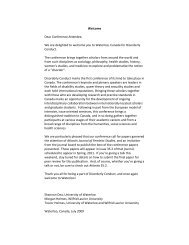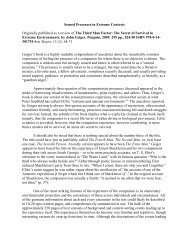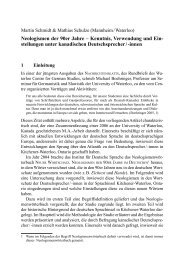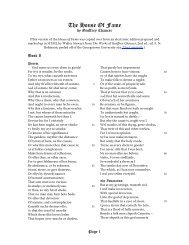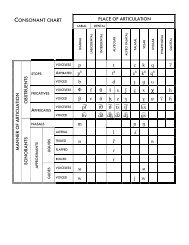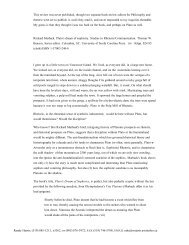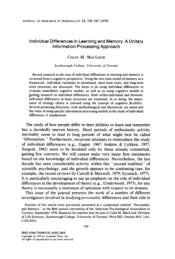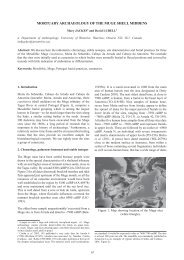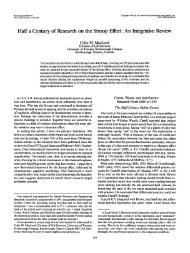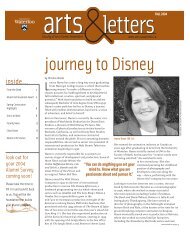The mid seventeenth century collapse of Iroquoian Ontario:
The mid seventeenth century collapse of Iroquoian Ontario:
The mid seventeenth century collapse of Iroquoian Ontario:
Create successful ePaper yourself
Turn your PDF publications into a flip-book with our unique Google optimized e-Paper software.
M. JackeS<br />
368<br />
population decline. Intensifying war, with many killed, taken captive or forced to become<br />
refugees, led to almost complete population <strong>collapse</strong>.<br />
We have no reason to enter into the thorny field <strong>of</strong> debating the whys and wherefores <strong>of</strong><br />
what happened in <strong>Iroquoian</strong> <strong>Ontario</strong> from 1642 to 1651. <strong>The</strong> basic facts seem indisputable<br />
and the Jesuit ethnohistorical record <strong>of</strong> them cannot be dismissed as self-serving and<br />
untruthful. Within those ten years, the Huron and Petun societies were destroyed, and many<br />
took refuge with the Neutral. <strong>The</strong> Iroquois then turned their attention to the Neutral.<br />
<strong>The</strong> demography <strong>of</strong> the Grimsby cemetery seemed originally to suggest very high fertility.<br />
However, the methods developed since the first analyses enable us to understand how<br />
the Grimsby cemetery does not contradict, but in fact fits with the ethnohistorical records in<br />
the Jesuit Relations.<br />
During the 1630s, perhaps into the early 1640s, the cemetery at Grimsby seems to have<br />
been dominated by two large multiple graves which contained a disproportionate number <strong>of</strong><br />
women and children. It is not possible that this would represent a normal biological population.<br />
<strong>The</strong> best interpretation is that Grimsby was a place <strong>of</strong> refuge, especially for women and<br />
children.<br />
<strong>The</strong> last period <strong>of</strong> Grimsby was a time <strong>of</strong> many deaths. Feature 62 is characterized by the<br />
number <strong>of</strong> older people, by the burial together <strong>of</strong> groups <strong>of</strong> individuals who have skeletal<br />
traits suggesting familial relationships, by many adult males. Feature 62 represents the last<br />
Neutral ceremonial burial. Again, the best interpretation <strong>of</strong> the feature is <strong>of</strong> an aggregation <strong>of</strong><br />
individuals in circumstances leading to members <strong>of</strong> the same families succumbing to death<br />
within a limited period <strong>of</strong> time. A possibility is the gathering <strong>of</strong> people into a sheltered area<br />
close to the lakeshore where food might have been available at a time <strong>of</strong> famine. Among these<br />
there could have been some Huron and Petun refugees as well as Neutral.<br />
Feature 1 displays no such ritualized burial. It appears to be the hasty collection <strong>of</strong> bones<br />
left broken and weathered, <strong>of</strong> incomplete and mixed individuals. Feature 1 was the last burial<br />
<strong>of</strong> the Neutral, apparently lacking the reverence for the dead which the Jesuits said characterized<br />
the Neutral. This would have occurred in 1651 during the final Iroquois onslaught,<br />
when it is recorded that the Neutral fled into the woods and dispersed for the last time. <strong>The</strong><br />
panic flight was induced by the knowledge <strong>of</strong> what had happened to their Huron and Petun<br />
neighbours, their cruel destruction by the Iroquois. <strong>The</strong> years <strong>of</strong> famine and disease no doubt<br />
contributed to the rout <strong>of</strong> what had been a strong, populous and war-like nation.<br />
Grimsby still presents a mystery, but one which is perhaps best understood in terms <strong>of</strong> its<br />
special location. A core area containing phase II beads represents a small area <strong>of</strong> burials, with,<br />
beyond this, burials <strong>of</strong> many women and children. Several elements are unusual among these<br />
burials, Feature 11, especially, containing an aberrant mix <strong>of</strong> beads. Beyond again, there lies<br />
a spread <strong>of</strong> many burial features, the majority identified as belonging to bead phase IIIb.<br />
<strong>The</strong>re appears to be an increasing number <strong>of</strong> burial features and an increasing number <strong>of</strong><br />
individuals buried, through a time <strong>of</strong> disease, famine and war, and through space, spreading<br />
east along the escarpment from the waterfall gorge.



